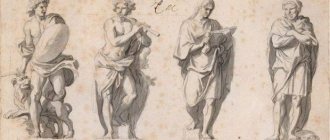We are all different. And we are talking not only about the external data that nature gave us. We differ from each other in behavior, reactions to certain situations, characteristics of interaction with society, mentality, etc. Human development has long been the object of study by psychologists and scientists. As a result of observations of people that have been going on since ancient times, various psychological typologies of personality have emerged.
They say that if you understand typologies, you can make your life a lot easier: firstly, you will understand yourself, your characteristics, strengths and weaknesses; secondly, at a minimum, learn to interact effectively with people. Is this really so and what personality typologies will help “reveal all the cards” of a person, we will tell you in this article.
Welcome to the world of amazing people!
Silent history
Personality typology in psychology is interpreted as a system of individual attitudes and behavioral stereotypes, formed to explain the differences between people.
Even in ancient times, scientists, writers and philosophers classified people according to various criteria. Aristotle introduced the concept of “virtue”. This is how he outlined the internal order and structure of the soul. Virtues, according to the philosopher, are divided into moral (ethical) and mental (reasonable).
Ethical virtues represent a mean between two extremes: excess and deficiency. They are characterized by courage, majesty, friendliness, ambition, truthfulness, courtesy, wisdom, etc. Regarding moral virtue, Aristotle said that it is “the ability to do the best in everything that concerns pleasure and pain, and vice is its opposite.”
Ethical virtues of character, according to the philosopher, are formed in the process of life and as a person gains experience, and rational virtues - through learning [A. Chanyshev, 1987].
In 314 BC. Theophrastus proposed his typology. For him, human character is a set of mental properties that are manifested in actions and words. He divided people into 30 types, which he described in detail in his work “Characters”. The names of the types speak for themselves: pretender, flatterer, gossip, talker, impolite person, curmudgeon, braggart, etc. [ABOUT. Freidenberg, 1941]
Hippocrates created the doctrine of the internal juices of man. He highlighted:
- yellow bile;
- black bile;
- blood;
- slime.
Depending on which fluid dominates in a person, he identified the following types of temperament: choleric, phlegmatic, sanguine and melancholic [B. Petrovsky, 1977].
This is one of the oldest personality typologies, which, despite the generality of characteristics, is still used today. We will return to it later.
Around the middle of the 20th century, the study of personality began to be given special importance. Various options have emerged for classifying people according to their distinctive characteristics. Among them were:
- Personality typologies of Ernst Kretschmer and William Sheldon: they explain the relationship between body type and temperament.
- Types of experiences: introverted, extroverted, ambiequal, coartistic, dilatory. This classification was put forward by Hermann Rorschach.
- Types of representations by Erich Rudolf Ensch : integral, differentiated.
- Forms of life activity , which, according to Eduard Spranger, are divided into aesthetic, religious, economic, social, power, theoretical, etc. [Org, 2017].
Most of the typologies proposed during that period have historical value and are practically not used today. But among them there are those that became the foundation for the development of psychology. We propose to consider them and more modern classifications of personality typologies further.
List of qualities
Personality structure includes temperament, volitional qualities, abilities, character, emotions, social attitudes and motivation. And also separately the following qualities:
- Independence;
- Intellectual self-improvement;
- Communication skills;
- Kindness;
- Hard work;
- Honesty;
- Determination;
- Responsibility;
- Respect;
- Confidence;
- Discipline;
- Humanity;
- Mercy;
- Curiosity;
- Objectivity.
A person’s personal qualities consist of internal perception and external manifestations. External manifestation includes a list of indicators:
- innate or acquired artistry;
- attractive appearance and sense of style;
- oratory skills and clear pronunciation of speech;
- a competent and sophisticated approach to non-verbal communication.
The main qualities of a person (her inner world) can be classified according to a number of characteristics:
- a comprehensive assessment of the situation and the absence of conflicting perceptions of information;
- an inherent love for people;
- open-minded thinking;
- positive form of perception;
- wise judgment.
The level of these indicators determines the individual characteristics of the individual being studied.
So what was Hippocrates talking about?
According to the teachings of Hippocrates, temperament is a certain behavior of a person, which is associated with the predominance of a specific fluid in his body. He believed that the presence of mucus (lymph) in large quantities determines the degree of balance of a person, i.e. the more lymph, the calmer the person.
A high concentration of yellow bile makes a person impulsive, black bile - sad and melancholic, and blood - energetic. Based on these data, Hippocrates identified four types of temperament that explain human behavior:
- Sanguine temperament: One who has this type of temperament is characterized by activity and balance. This is a fascinating personality who willingly takes part in various events. She is characterized by a quick change of emotions, bright facial expressions and pantomime, and expressive laughter. Sanguine people have a high sensitivity threshold, so they do not react to distractions (sound, light). People of this type of temperament are distinguished by their efficiency and energy; they easily adapt to new conditions due to their flexibility and quickly switch attention from one thing to another. They are also distinguished by their speed of reaction, which is expressed in movements, speech, and love vivid impressions. These are typical extroverts. The dominant fluid is blood.
- Choleric temperament: choleric people are highly reactive, which is why they are often quick-tempered, impulsive, and unrestrained. Unlike sanguine people, such individuals are less flexible, therefore they strive to be stable in everything and have difficulty switching their attention. The dominant fluid is bile.
- Phlegmatic temperament: people of this type of temperament are active and balanced. There is little that can piss them off and force them to express their feelings. They are unemotional; it will be very difficult to make them laugh or cry. Phlegmatic people's facial expressions and gestures are monotonous and express practically nothing. They have difficulty adapting to new circumstances and shifting their attention. Such people live “within themselves”, it is difficult for them to make acquaintances, they do not like to be the center of attention, phlegmatic people are introverts. The dominant liquid is mucus.
- Melancholic temperament: melancholic people are characterized by low reactivity and high sensitivity. Such people are easy to offend; they can burst into tears even for a minor reason. They have inexpressive facial expressions, a quiet voice, and slow movements. Melancholic people get tired quickly. Such people are insecure and find it extremely difficult to adapt to a new environment, although in familiar circles they can be very sociable and tactful. As a rule, these are introverts. The dominant liquid is black bile [Yu. Aleksandrovsky, 2021].
Surely, reading the descriptions of each type of temperament, you found something similar to your character. It is almost impossible to meet, for example, a sanguine person or a choleric person in their pure form, because... Each personality is a combination of all four types of temperament.
Moreover, there is always one dominant type, and all the others complement it. If a person has all four types of temperament in approximately equal proportions, such a person is called a tetravert. To most accurately determine the type of temperament, it is enough to take the Hans Eysenck personality questionnaire or the Pavlovian temperament questionnaire (“Strelyau Questionnaire”).
Jung's personality typology
The teachings of Carl Gustav Jung, a Swiss psychologist and psychiatrist, were based on the observation that some people's lives can be directed towards their own interests and interactions with the outside world, while others can be directed towards their own inner world. Based on this, he identified two main types of people:
- Extroverts: the consciousness of a person of this type of personality is directed to the outer world, and issues of the inner world always remain in the background.
- Introverts: the personality’s psyche is focused on internal processes, the outside world is of little interest to them.
In simple terms, an extrovert will always be happy to spend time with people, he is sociable and open, while an introvert will prefer privacy with himself, he is not so sociable and does not like to be the center of attention.
Jung divided personalities not only according to the universal criteria of extraversion and introversion, but also according to psychological functions, which included thinking, intuition, feeling, sensation. As a rule, one of these functions predominates over the others, forming a certain psychological type.
He divided functions into rational ones, which lie in the sphere of the mind (thinking, feeling) and irrational ones, which are outside the mind (sensation, intuition). The dominant function suppresses the opposite function, for example, intuition excludes sensation, and thinking excludes feeling [D. Sharp, 2008].
Thus, eight personality typologies were identified:
- Extroverted thinking type: a person perceives information through objective facts and reduces everything he encounters into a single scheme, with the help of which he then explains all other phenomena. He has good organizational skills and prioritizes global plans over individual plans.
- Introverted thinking type: such a person perceives reality through subjective internal perception. A person with such a psychotype, when studying a question, gets to the very core of the essence. He also follows his ideas, like the extroverted thinking type, only he does not develop them “outside”, but deepens them “inside”.
- Extroverted feeling type: a person perceives the world through his own senses, paying attention even to small details. He is impulsive, sociable and has flexible behavior, but is not very intelligent.
- Introverted Sensing Type: These people focus on their own internal emotions and feelings. Outwardly, they look calm and even passive, because their energy is aimed at processing internal sensations. As a rule, such individuals are closed and constantly engage in introspection, but at the same time maintain reasonable self-control.
- Extroverted Feeling Type: This type of person easily perceives the intentions of others. It is important for him to understand what the main values of the environment in which he is located are, to correspond to them, and for others to correspond to these values. This personality type is mainly found in women, because most often it is the fair sex who live with sensations that interfere with thinking.
- Introverted feeling type: a person of this type of personality has a sensitive perception of the surrounding reality and is prone to deep inner experiences. He is distinguished by silence, secrecy, he is a mystery to others, because... The true face is hidden behind a mask.
- Extroverted intuitive type: this type of personality is characterized by an endless search for new opportunities and excessive enthusiasm for prospects, which leads to a constant change of activity. A person of this type easily charges people with his energy, but at the same time he cares little about his health, which he can lose in the pursuit of something new.
- Introverted intuitive type: such a person is able to grasp what others cannot. As a rule, people of this type become creators and create something outside the usual, and some of them remain “unrecognized geniuses” because of their non-standard view of things [K. Jung, 2001].
Carl Gustav Jung devoted about twenty years to the study of personality types. He described his research and observations in detail in the book “Psychological Types.” Subsequently, this typology continued its development in the works of other scientists, in particular, Isabel Briggs Myers developed her own typology, which was based on the teachings of Jung. By the way, you can take the Myers Briggs Personality Type Test (MBTI) here .
Socionics: methods for determining sociotype
Traditionally, to determine a person’s sociotype (typing), the following are used:
- Socionic tests and questionnaires . The Myers-Briggs questionnaire is very popular (you can take it here), although experienced specialists (socionists) point out that the Myers-Briggs typology does not fully correspond to the socionic typology, so these questionnaires are adapted. There are also Weisband and Meged-Ovcharov tests, Talanov questionnaires, Gulenko test, Lytov multifactor test, Keirsey socionic test.
- Socionic interviews . This is a conversation between a socionicist and a person being typed on an arbitrary or planned topic (often accompanied by testing or questioning). When conducting a diagnosis, the specialist evaluates how clearly the signs of IMT and some other specific parameters are expressed. After this, the socionician compares the received data and makes a conclusion about TIM.
- Experiments . To implement this method, as a rule, socionics create special conditions for those being typed and set specific tasks for them. In the process of completing tasks, specialists monitor people’s actions, reactions, decisions, and then draw conclusions about TIM.
- Observations . A specialist observes a person (or a group of people), evaluates his appearance, behavior, actions, and non-verbal manifestations. But in order to draw reliable conclusions, a socionicist must have the skill of figurative-sensual recognition of TIM based on impressions.
- Research dossier . Socionics studies a person’s personal file, eyewitness accounts, personal texts and/or diary entries, photo and video materials, and creative results.
It is believed that experienced people and professional specialists can determine a person’s sociotype by his reactions, appearance, manner of communication and even style of clothing, without resorting to lengthy research. In addition, some are able to adequately determine their own sociotype. But in order to achieve such a level in socionics, it is necessary, firstly, to understand in detail the system of this direction and its sociotypes, secondly, to study the psychotypes proposed by Jung’s theory, and thirdly (if it comes to self-typing), to learn objectively perceive and evaluate yourself, your character traits, reactions and other features of your personality. We should not forget about the main problem of socionics - that from a scientific position it lacks objective criteria for determining the socionic type. In other words, any analysis of a person using socionics will not have reliable scientific justification.
However, if you learn to identify sociotypes, you will be able, with a certain degree of probability, to establish what the behavioral differences between people are and look for the right approach to them, determine the habits, interests and abilities of those around you, and understand what dictates their actions and actions. Possessing socionic knowledge, a person is also able to determine his compatibility with people, predict the development of relationships, highlight which qualities in other people should be perceived as basic, and which it makes sense not to pay special attention to. In short, socionics, despite the lack of scientific status, can be very useful, both for one person and for society as a whole.
DISC personality typology
DISC is a four-quadrant behavioral model that explains people's behavior in certain circumstances. This model does not take into account a person’s mental abilities, experience, education and other characteristics, but identifies four aspects that speak about a person’s preferences:
- d ominance – dominant, “red” (D);
- i nducement – influencing, “yellow” (I) ;
- s teadiness – stable, “green” (S);
- c ompliance – conscientious, “blue” (C) .
The founder of this personality typology is William Moulton Marston, psychologist, comic book author and creator of the polygraph. He believed that a person's behavior depends on how positively he perceives the environment and on the speed of his reaction to various situations. He described his teachings in the book “The Emotions of Ordinary People”; later they became the foundation for the development of the DISC typology [Hr-director, 2021]:
To better understand what we are talking about, let's take a closer look at each personality type:
- Dominant, “red” (D): the main motivation of such people is victory. They do not tolerate defeat and always strive to be leaders. They are driven by passion and competition. Strengths are the ability to work for results, an active life position, determination, flexibility and endurance. But at the same time, they cannot always find a common language with others, often lose sight of details and are prone to aggression if they are under stress. They can be excellent managers and formal leaders.
- Influential, “Yellow” (I): They are motivated by new opportunities and recognition. “Yellows” are characterized by enthusiasm, a positive outlook on life and energy; it is important for them to be in the center of attention. Such people have unconventional thinking, goodwill, and creativity. Impulsiveness, unpunctuality and lack of attention to detail are their weaknesses. They make good specialists in the creative field or HR services, because “yellows” know how to motivate people and resolve conflicts.
- Stable, “green” (S): people of this type strive for consistency and really dislike change. They are always ready to listen and support; they are born psychologists. The main value of “greens” is good relationships in the family, at work, and with friends. Order in everything, attention to detail, reliability are their strong point. But there are also disadvantages: it is difficult for them to refuse, they talk little about problems and are often touchy, which leads to psychosomatic disorders.
- Conscientious, “blue”, (C): these are fighters for what is right and lovers of consistency in business. Making a mistake is unacceptable to them. “Blues” do not express their emotions, they are closed and secretive, preferring loneliness. People of this type are very neat, pedantic and completely inflexible, and when stressed they often withdraw into themselves. Any position that requires accuracy, attentiveness and scrupulousness (accounting, human resources department, etc.) is suitable for them [HR-Portal, 2019].
As a rule, each of us contains all four personality types, but one of them will dominate. This typology is widely used in personnel selection to assess how well the candidate’s natural qualities match the current position.
Reasons for dividing people into types
The psychological type of personality is a certain model of human behavior and his interaction with others and the environment. Classification into psychotypes provides simply limitless possibilities: the type of people allows you to predict in advance what can be expected from them, how they will behave. This helps to build or, conversely, get away from relationships.
There are different types of personality behavior in sociology. There are many names, distributions and divisions. An attempt to unite certain groups of people by behavior and thinking really yielded results - it is easier for investigators to search for criminals and see their “handwriting”, it is easier for doctors to understand patients by their appearance, it is easier for psychologists to predict the outcome of consultations.
Social typologies of personality
The peculiarities of personality formation are explained not only by psychology, but also by the influence of culture, history, and socio-economic living conditions.
Erich Fromm, a German-American psychologist, studied the issue of personality development since the end of the Middle Ages and came to the conclusion that isolation, loneliness, alienation are an integral part of human life, and that each historical period when humanity fought for its freedom and development, in its own way influenced the formation of behavior and attitudes.
Based on his observations, he identified five types of social character:
- Receptive orientation: people of this nature underestimate their potential and believe that they cannot be a source of anything good. They depend on the opinions of others, are not independent and constantly need approval and praise. The position of such a person is to be loved, not to love.
- Exploitative orientation: such people always look for their own benefit in everything. They achieve goals with strength and intelligence and are often ready to deceive and borrow other people's ideas for the sake of success.
- Acquisitive orientation: these individuals are very dependent on material goods, they are also called “hoarders”, because the more things they have, the calmer they feel. At the same time, they do not like to spend money, they constantly think about the past, and something new causes them fear.
- Market orientation: and here we are talking about the constant desire for financial success and the search for commercial gain. This is why people with a similar character establish any connections. Prestige and power are important to them; they clearly demonstrate their personal traits in order to look “more expensive” in the eyes of others.
- Fruitful orientation: this type of character, according to the scientist, is the ultimate goal in human development. Such people are calm, honest, independent, and prone to socially useful actions.
Erich Fromm divided these types of characters into fruitful (market and fruitful orientations) and unfruitful (receptive, acquisitive and exploitative orientations). Like other typologies, these types do not exist in a pure form, but are a combination of dominant and auxiliary character types [E, Fromm, 2006].
Eduard Spranger, a German philosopher of life, teacher, psychologist, in his book “Life Forms” identified six main personality types, each of which differs in perception of reality, values, motivation, etc. Here they are:
- Theoretical person: the highest form of activity for him is knowledge. It is important for him to be independent of specific goals; other values fade into the background.
- An economic person: it is important for him to benefit from everything to achieve his goals, so he saves resources.
- Aesthetic person: the highest value of the individual is harmony and aesthetics, the external world is assessed from the point of view of grace and suitability to the situation.
- A social person: love is the main principle of his life, and it must carry a religious meaning.
- Powerful person: Dominance over others is the dominant goal of the individual. He eschews any restrictions, and his boundless imagination helps to implement global projects that bring him fame.
- Religious person : focused on searching for the meaning of life and higher spiritual power [IP RAS, 2018].
Eduard Spranger believed that raising a child should be based on an understanding of what type of orientation he belongs to. Based on this, the teacher must instill in students certain life orientations.
So why do we need all this?
Today there are so many personality typologies that you involuntarily begin to doubt whether you need to bother yourself with them? The answer is clear – of course you need it! But just don’t score, but at least show interest in them.
First of all, the ability to understand psychotypes is useful for ourselves. If a person understands what type of personality he is, he will know his strengths and weaknesses, which means he will be able to competently manage them. This is a way to discover new opportunities for yourself, because often people tend to follow stereotypes or advice rather than listen to their own nature.
This is the case when a born speaker goes to work as an accountant, because, as his mother said, he will always have some money. As a result, no pleasure from work, no energy and no future prospects.
Cholerics, for example, make good bosses. They can handle any job that requires a lot of energy: journalist, coach, teacher, etc. Sanguine people easily find companionship, they can lead people, and they have good organizational skills. Phlegmatic people are strong in precise disciplines, while melancholic people are hard workers who love to work alone and require attention to detail.
As you can see, knowledge of the fundamental typology of Hippocrates’ personality already gives an understanding of what’s what. Now imagine what will happen if a sanguine person is seated at the mathematician’s table, and even alone?
Almost all HR specialists use various methods for assessing personality typology in their work. This is necessary both in personnel selection and in personnel changes, because an employee’s good results in an ordinary position do not always indicate that he will be an excellent leader; perhaps he lacks a natural manager, so a comprehensive assessment of personnel is important.
Surely, each of us has friends with whom we just can’t find a common language, or even some we consider, as they say, “not of this world.” There may be a conflict and misunderstanding with someone, because often people who are accustomed to being open with others, sociable and energetic perceive the slowness or isolation of their interlocutor, friend or colleague, as a kind of challenge, a negative personal attitude, which, naturally, is a mistake .
It is important to understand that there are no bad personality types, there are people with their own characteristics of character and behavior that are inherent to them by nature. It is the ability to assess a psychotype that helps to find a common language with others, prevent and resolve conflicts, and even agree on something.
And it is also important to understand that there are personality types that, in tandem, provide maximum or minimum productivity. If we look at the example of the DISC model, “red” interact best with “yellow”, but it is better not to pair them with “blue”, because These are two diametrically opposed personalities.
If you correctly consider the information about what type of personality your interlocutor (relative, colleague) belongs to, you can easily find the necessary levers to achieve maximum efficiency in communication. For example, with “yellows” you need to be positive in your communication, more often interested in their opinions, and to argue your point of view, refer to the views of authoritative individuals. You shouldn’t talk only about business with the “greens”. Informal communication is best suited to resolve various issues [O. Knysh, 2019].
Moreover, according to some psychologists, each personality type has its own illnesses. More precisely, if some character trait of a person is exaggerated or, conversely, strengthened, then mental abnormalities may appear. This relationship is clearly shown by the “7 radicals” personality assessment method, where all the names of radicals are derived from the names of diseases: schizoid, epileptoid, hysterical, hyperthymic, paranoid, emotive, anxious [V. Ponomarenko, 2006].
We are all individual and have our own set of personal qualities and character traits, which means that each person needs different approaches to communication, and if we are talking about children, then based on the child’s personality type, it is possible and necessary to build an individual education system.
If you find it difficult to determine on your own which personality type is dominant and which are auxiliary, and also cannot sensibly assess your strengths and weaknesses, we advise you to follow this useful link and discover the wonderful world of self-knowledge.
Psychotypes according to Freud
Sigmund Freud founded the first school of human psychology. Firmly convinced that childhood is the basis for the development of personality, he emphasized the study of children, highlighting the types of psychotypes. The scientist believed that the experiences and stress received by the child would leave a mark on the psyche and result in problems with health and behavior.
He divided childhood into several stages, the definitions of which are formed from the influence of various organs and sexual zones. According to Sigmund Freud, a child is born with a certain amount of psychosexual energy, which subsequently goes through all stages. The development of libido is formed into 4 human psychotypes. He called the first three pregenital (oral, anal, phallic - from 0 to 5 years), and the fourth - genital (puberty).
Summarize
Each personality combines unique patterns of behavior, ways of perceiving the world, and a certain reaction to events. Among us there are no “pure” representatives of a certain typology; we combine various character traits that were given to us from birth or acquired in the process of life.
It’s amazing how carefully the ancient knowledge about human personality types is passed on from generation to generation to this day, despite constant changes in the outside world. They help us understand ourselves, our strengths and weaknesses, opportunities and prospects, and a detailed study of a specific personality type helps us understand the intricacies of communication, methods of persuasion, and even methods of resolving conflicts.
Knowledge of personality typologies and the ability to correctly evaluate people radically change the picture of the world: now what previously seemed strange is perceived as nothing more than a property of a certain human psychotype. Today you don’t need to be a born psychologist and know all the characteristics of personality typologies by heart; just take several online tests to determine your psychotype, and you will receive a detailed description of your “I” and recommendations.
We wish you good luck and suggest answering the question on the topic of the article:
How to determine a person's psychotype?
The Swiss C. G. Jung became the first creator of the classification of psychotypes, which laid the foundation for the science of personality - socionics. The interaction of an individual in society is based on theories of other teachings about human behavior.
In total, the scientist identified eight types. Socionics has identified 16 types, taking as a basis two areas of personality: introverts and extroverts. The first ones have the following names and characteristics:
✔️Logical-intuitive. Doesn't like empty talk, communicates in essence. Uses logic or intuition to answer questions.
✔️ Intuitive and logical. He is careful in decisions, weighing the pros and cons, and does not take risks. Loves comfort and tranquility in everything.
✔️Logical-sensory. Pedant and realist.
✔️ Sensory-logical. Punctual, honest, sensitive.
✔️ Ethical-intuitive. A good friend who empathizes and gives advice has the qualities of a nurturer.
✔️ Intuitive and ethical. He feels people and can win them over. Likes to look good and relax.
✔️ Ethical-sensory. He doesn’t let strangers into his soul, he stands up for his family.
✔️ Sensory and ethical. He tolerates routine calmly, does not conflict, appreciates attention and care.
The second direction has the same names, but with an extraversion bias.
✔️Logical-intuitive. Soberly assesses circumstances, which does not interfere with risk. Able to not succumb to provocations, strictly following his goal.
✔️ Intuitive and logical. He does not like monotony, he is full of new ideas, bringing them to life.
✔️Logical-sensory. He is caring and sociable with loved ones, but sometimes stubborn. Perhaps this helps to always finish what you start.
✔️ Sensory-logical. A born winner at any cost. Tends to subjugate.
✔️ Ethical-intuitive. An emotional and persistent personality, he calculates everything in advance.
✔️ Intuitive and ethical. Thanks to his powers of observation, he senses people's moods. Will support you in difficult times.
✔️ Ethical-sensory. He has influence over people, but is also capable of self-sacrifice.
✔️ Sensory and ethical. Knowing how to manipulate people, he hides his true nature so that it will not be used against him.
The given characteristics are very relevant in our time, they help to identify problems in society.










